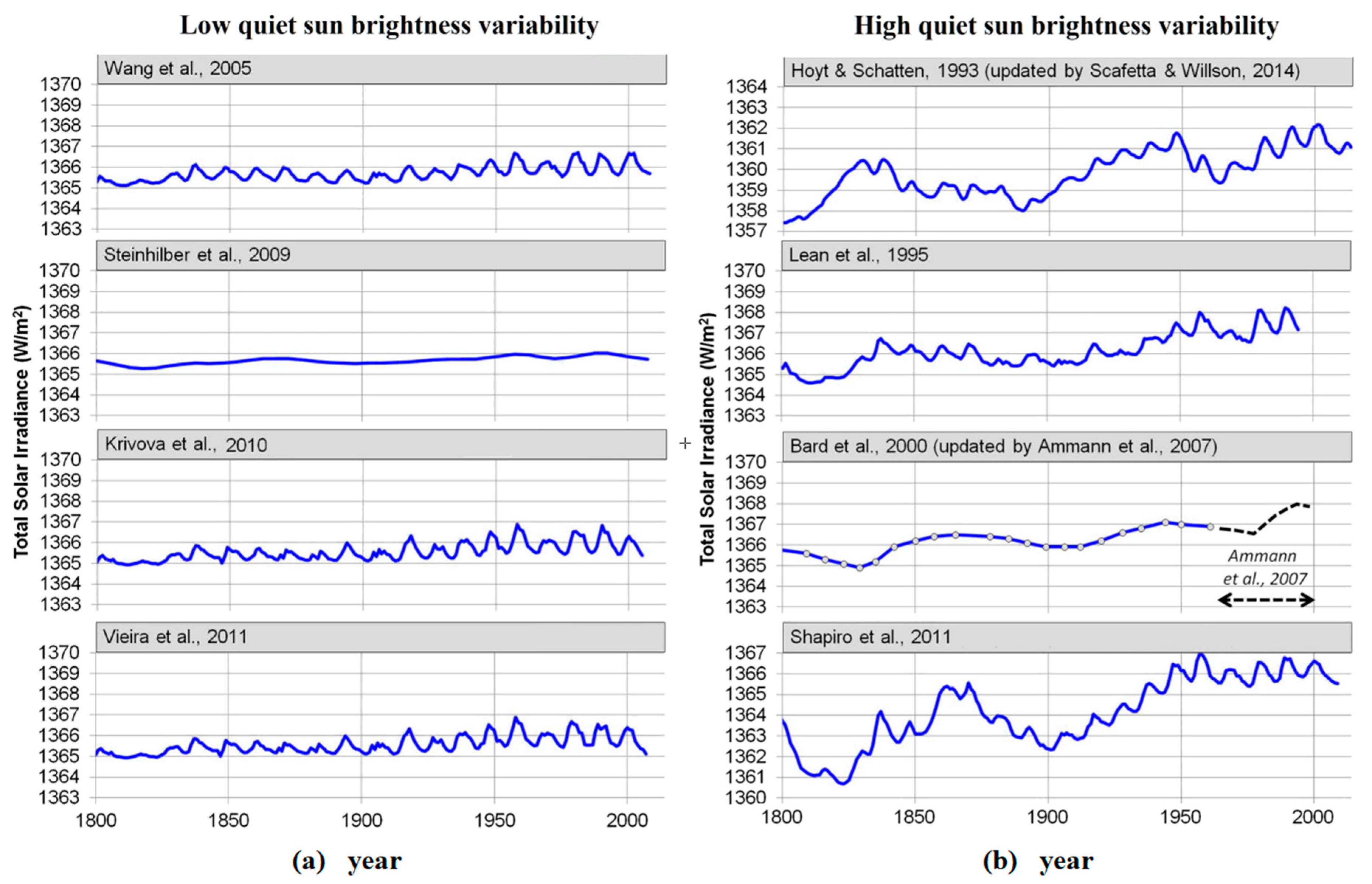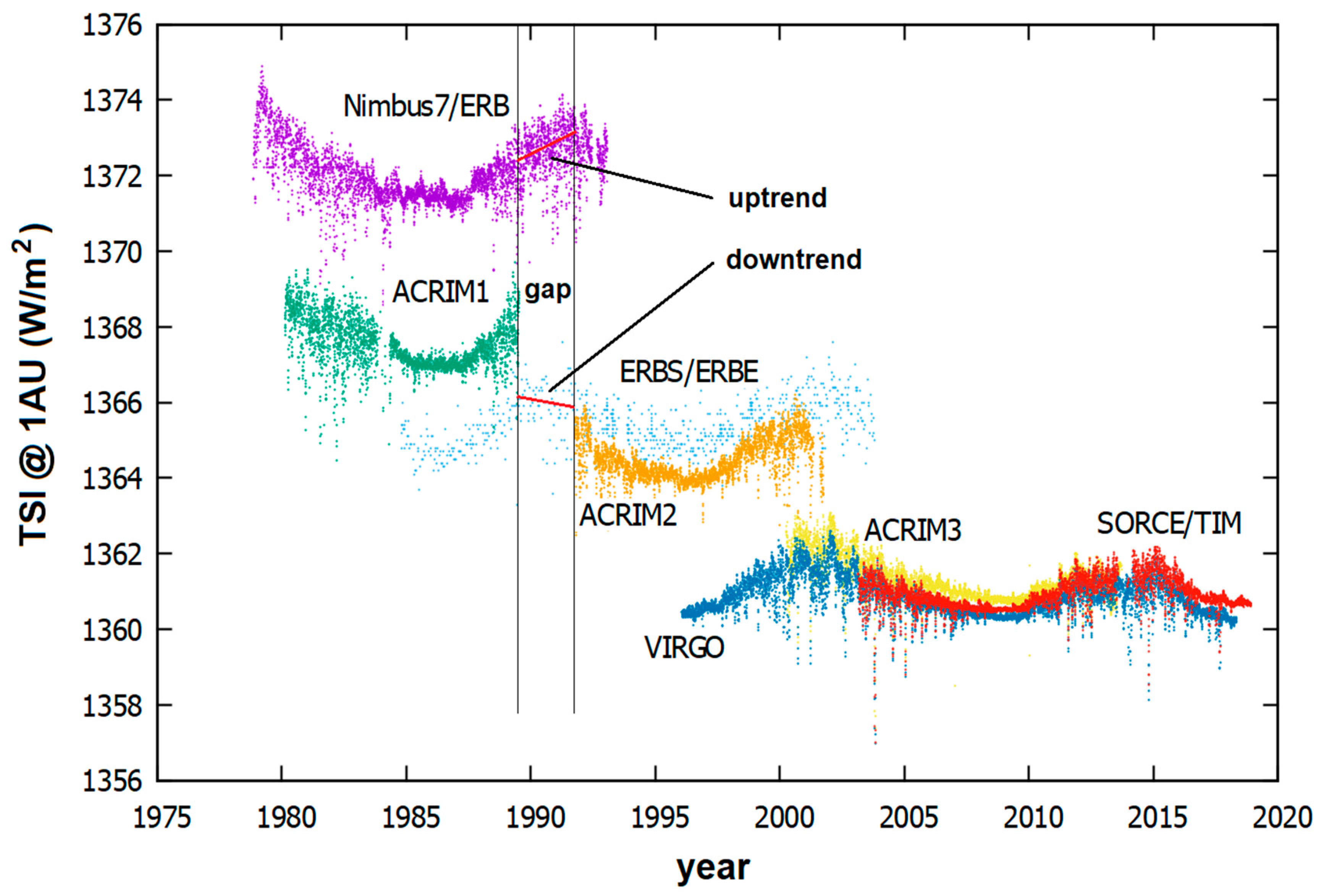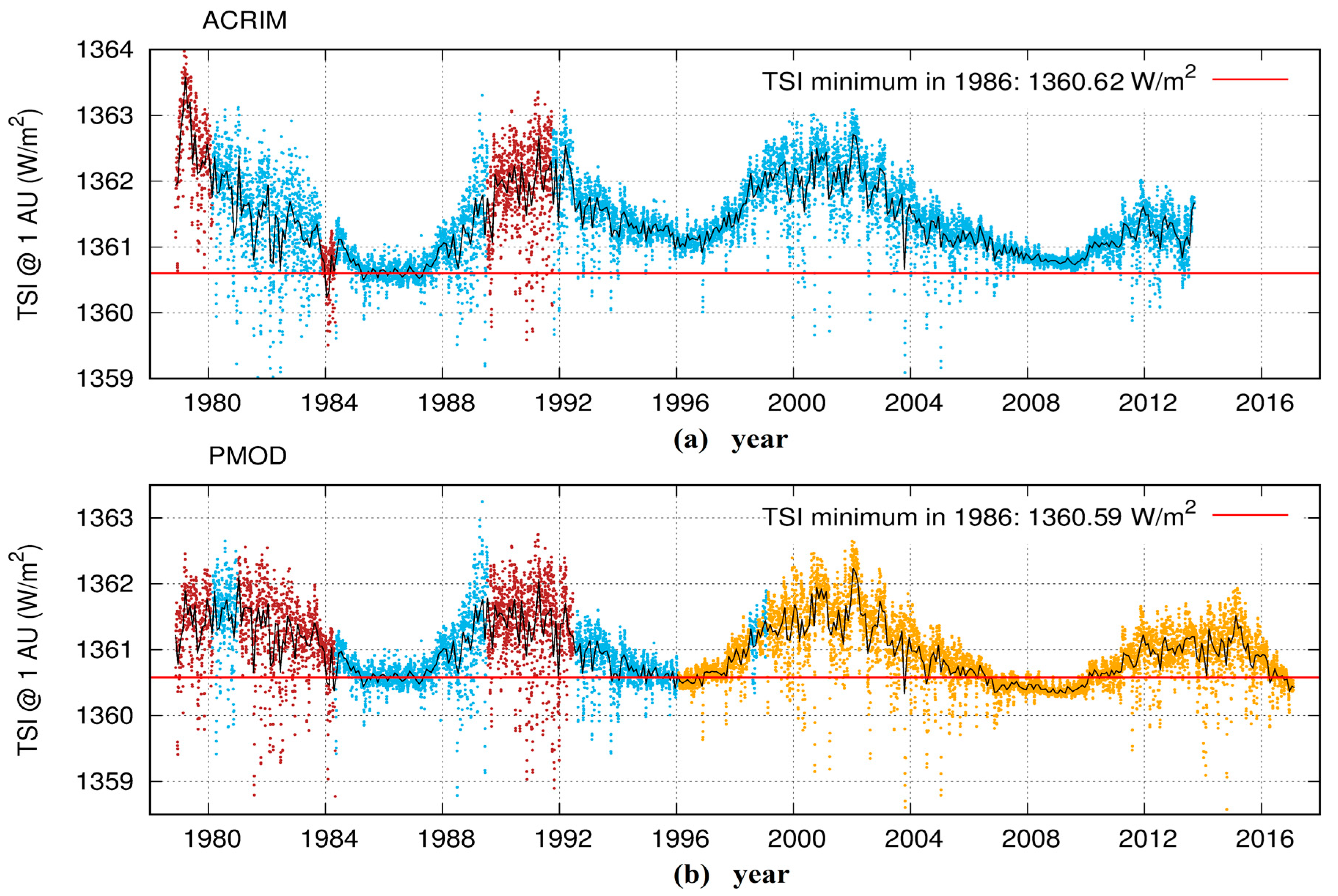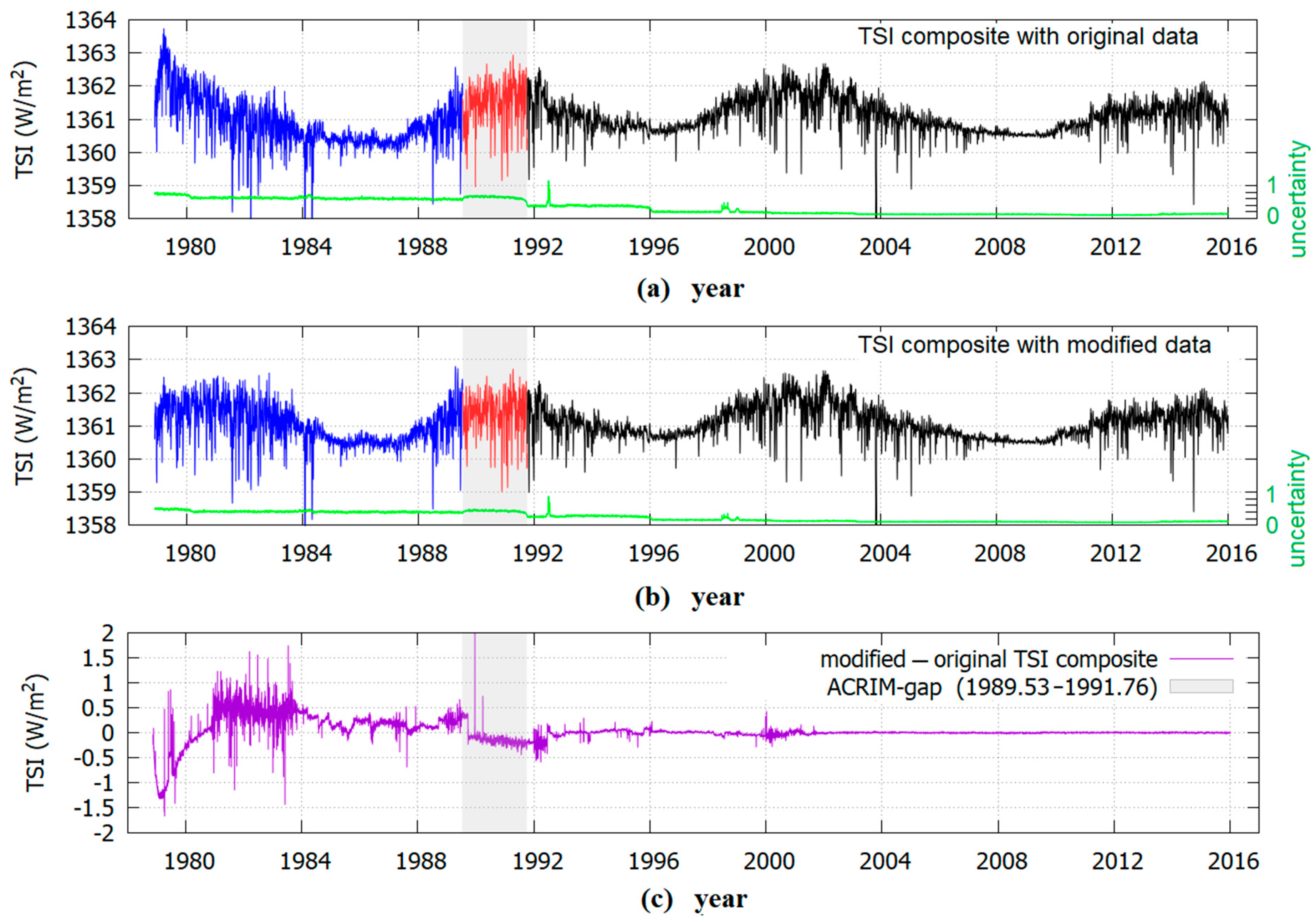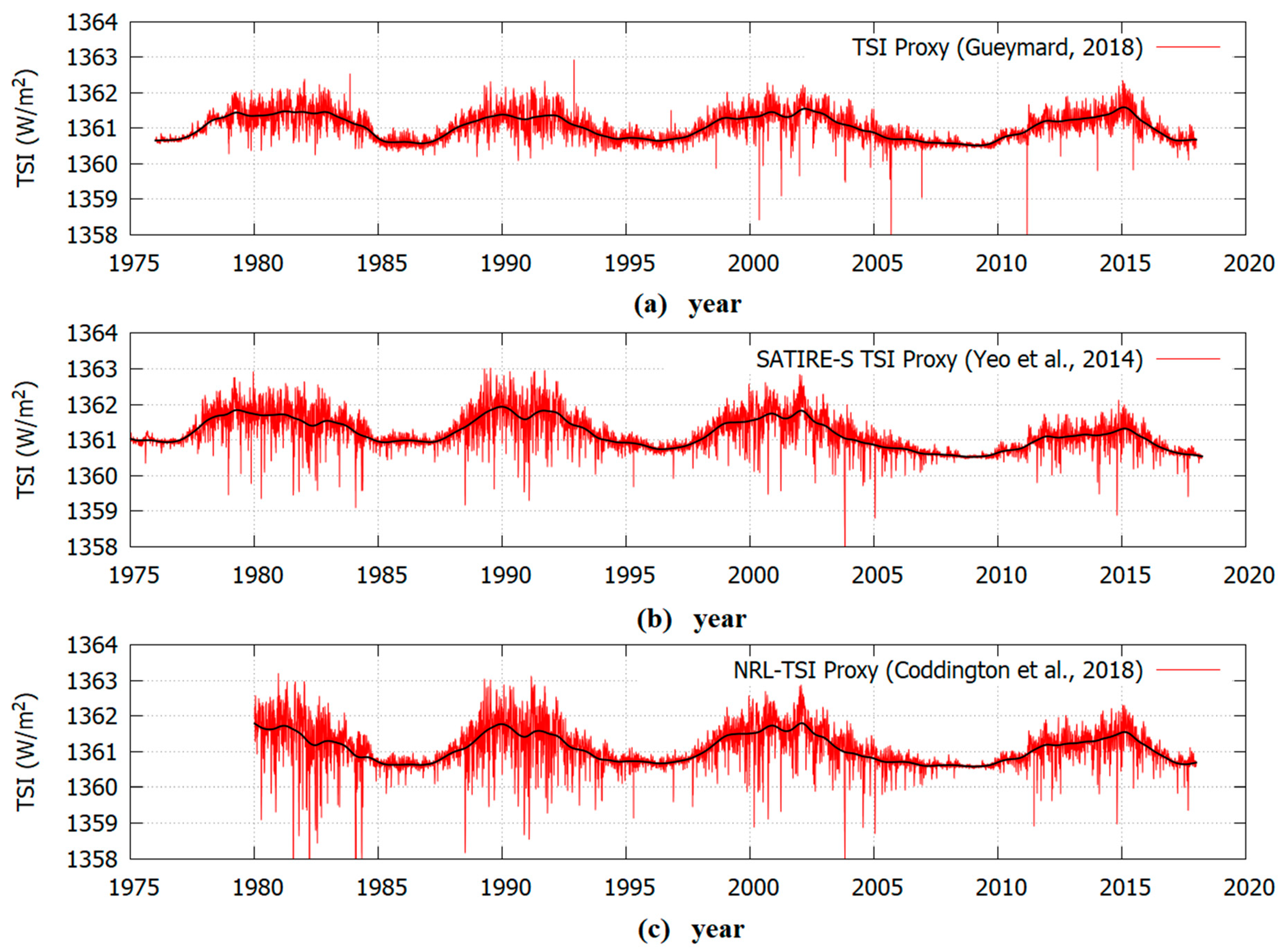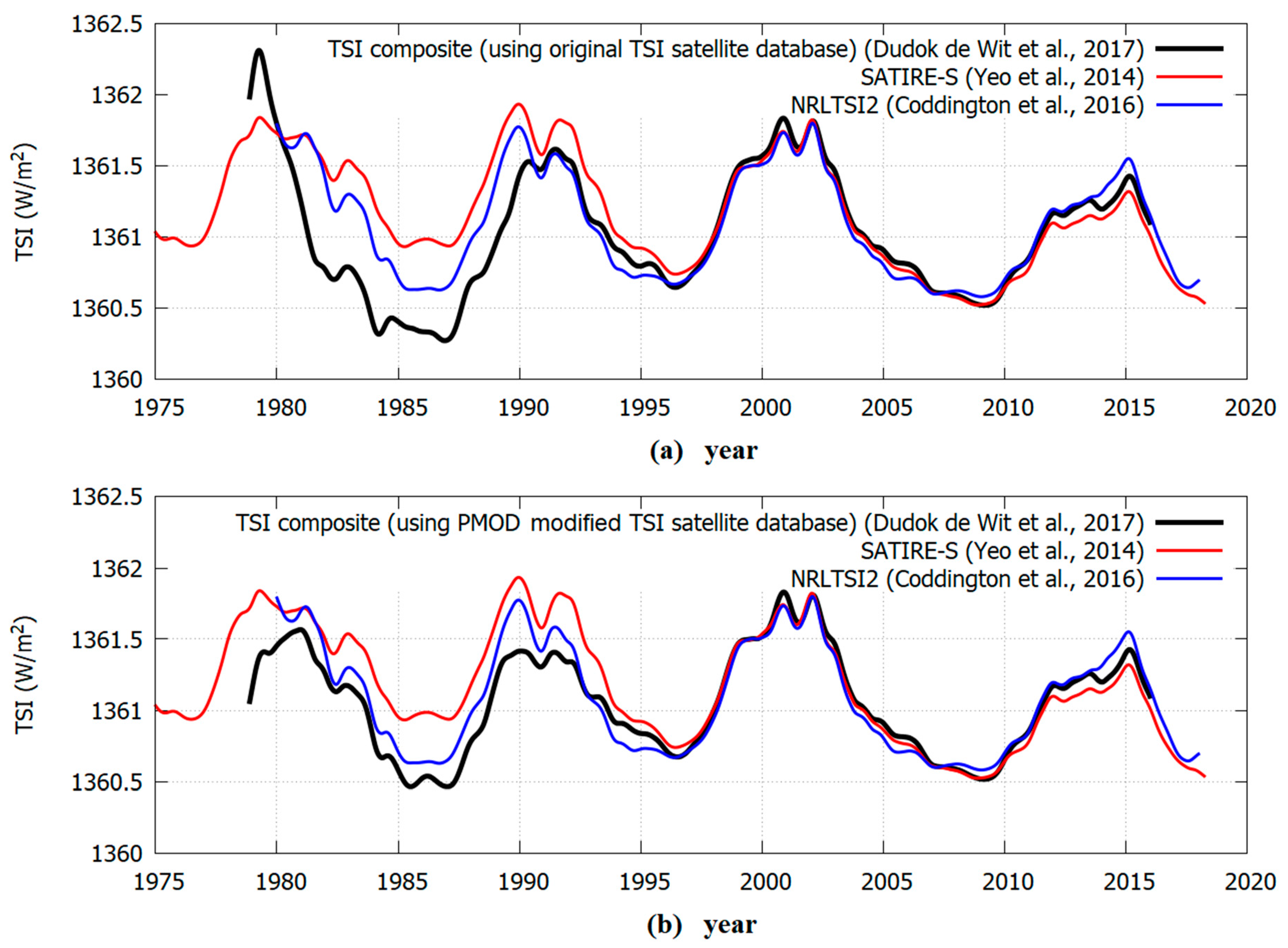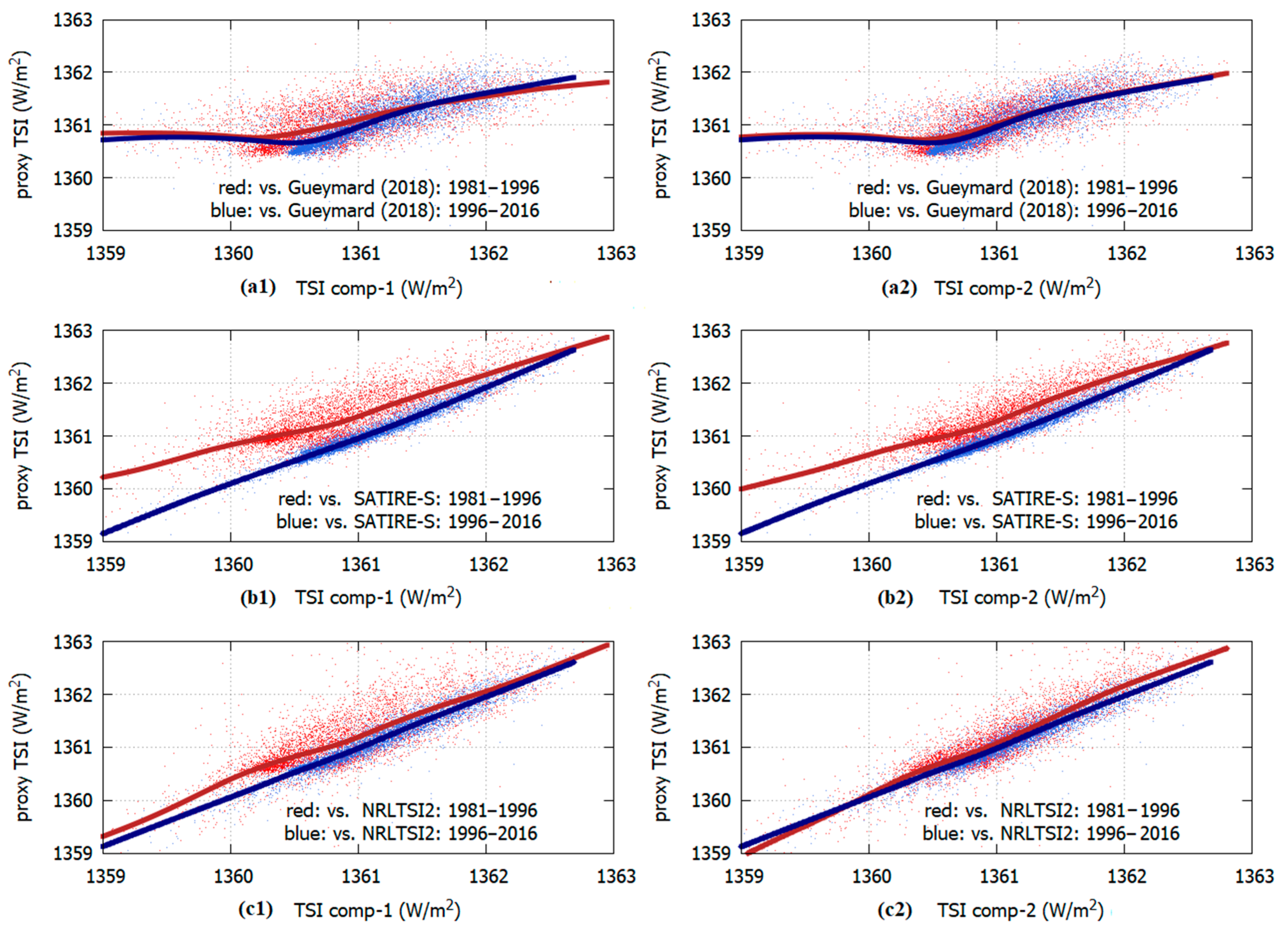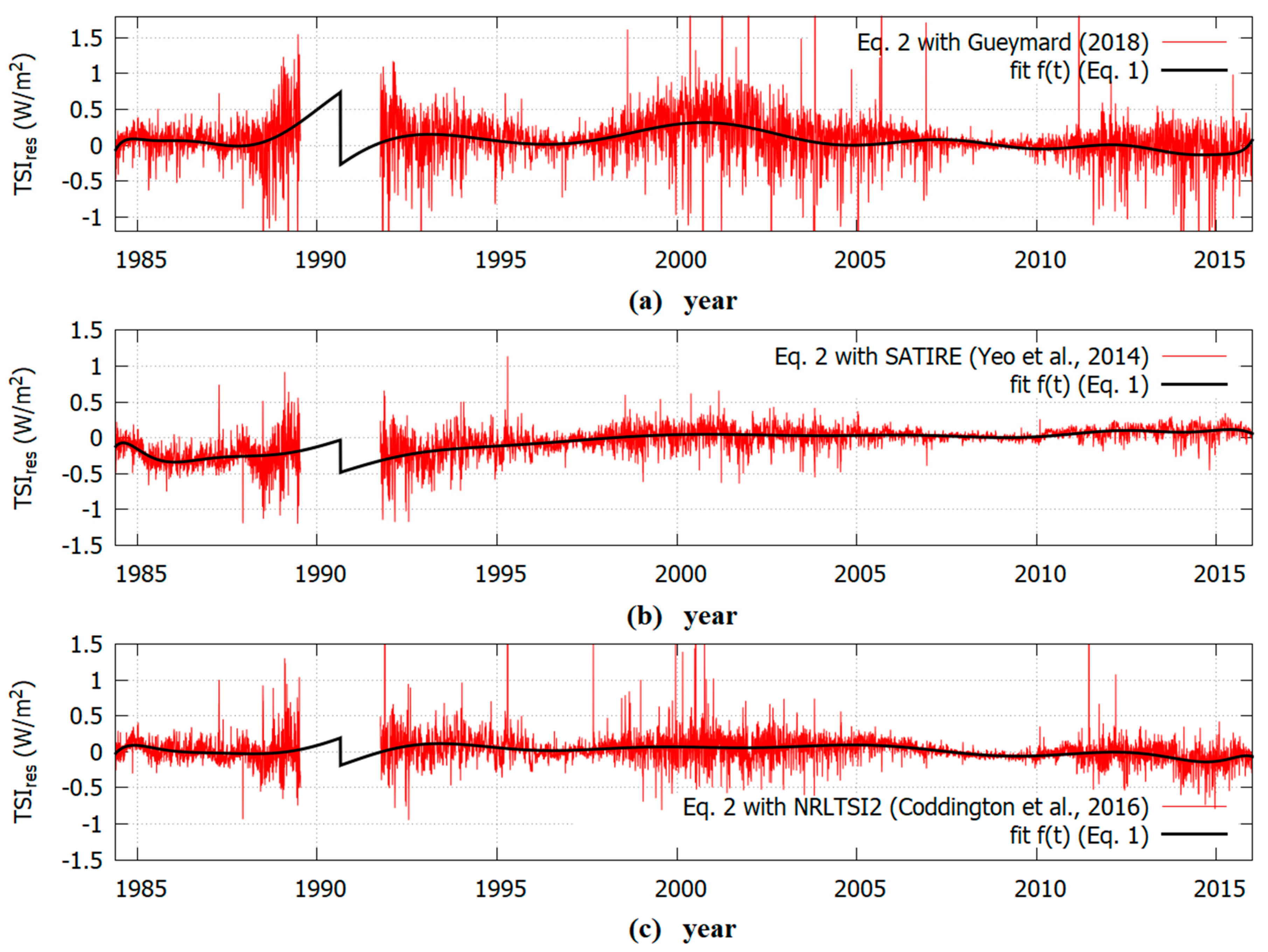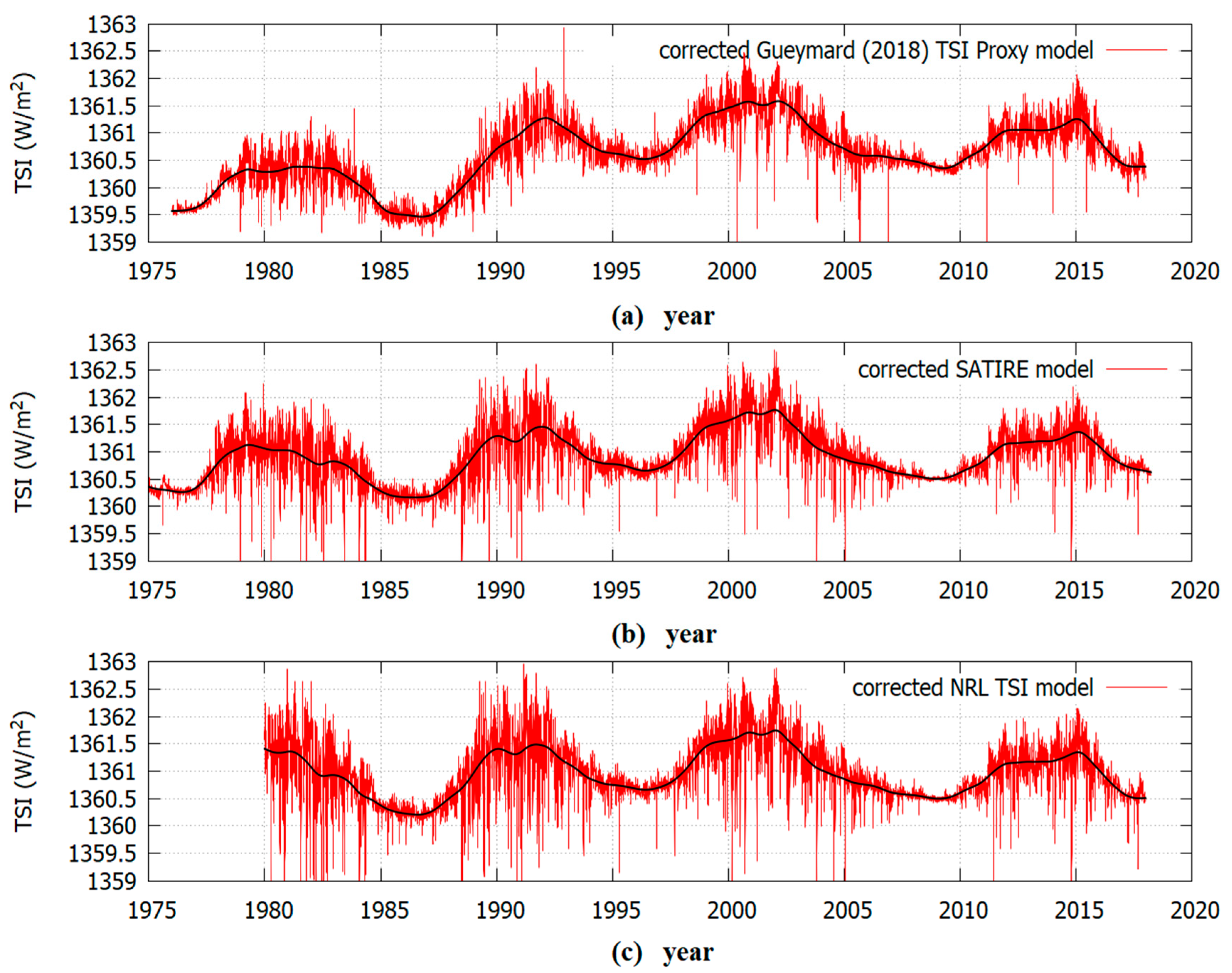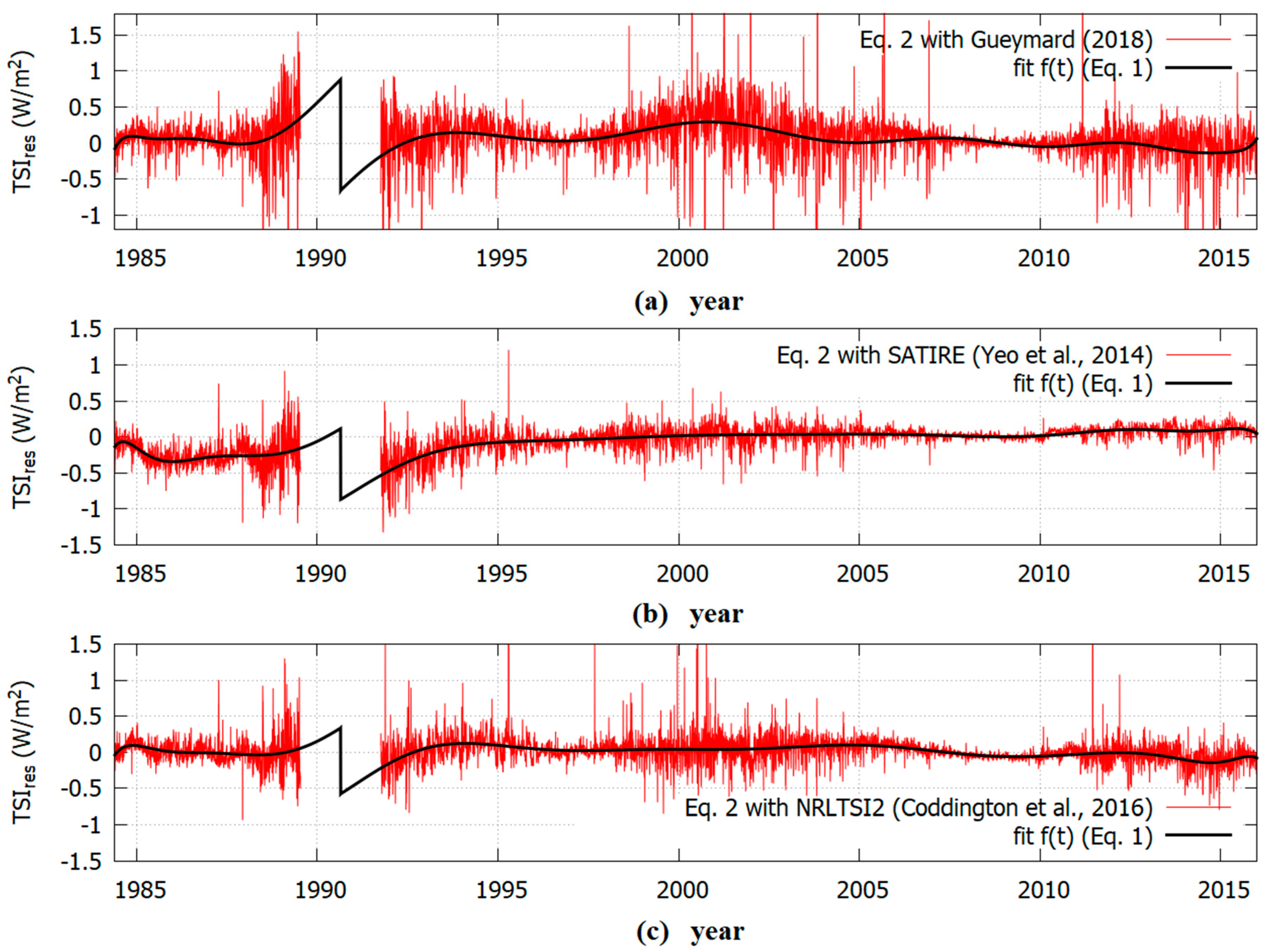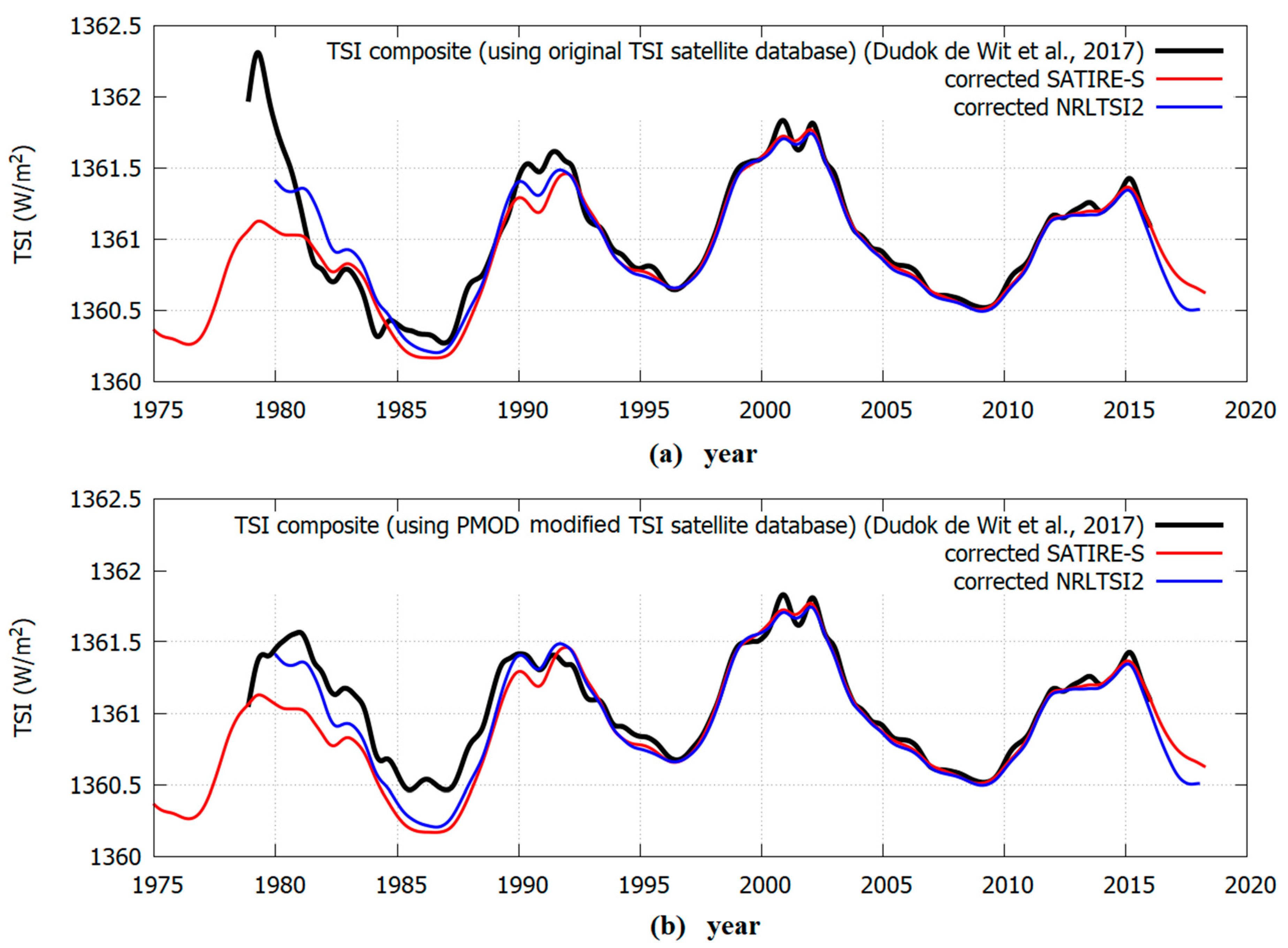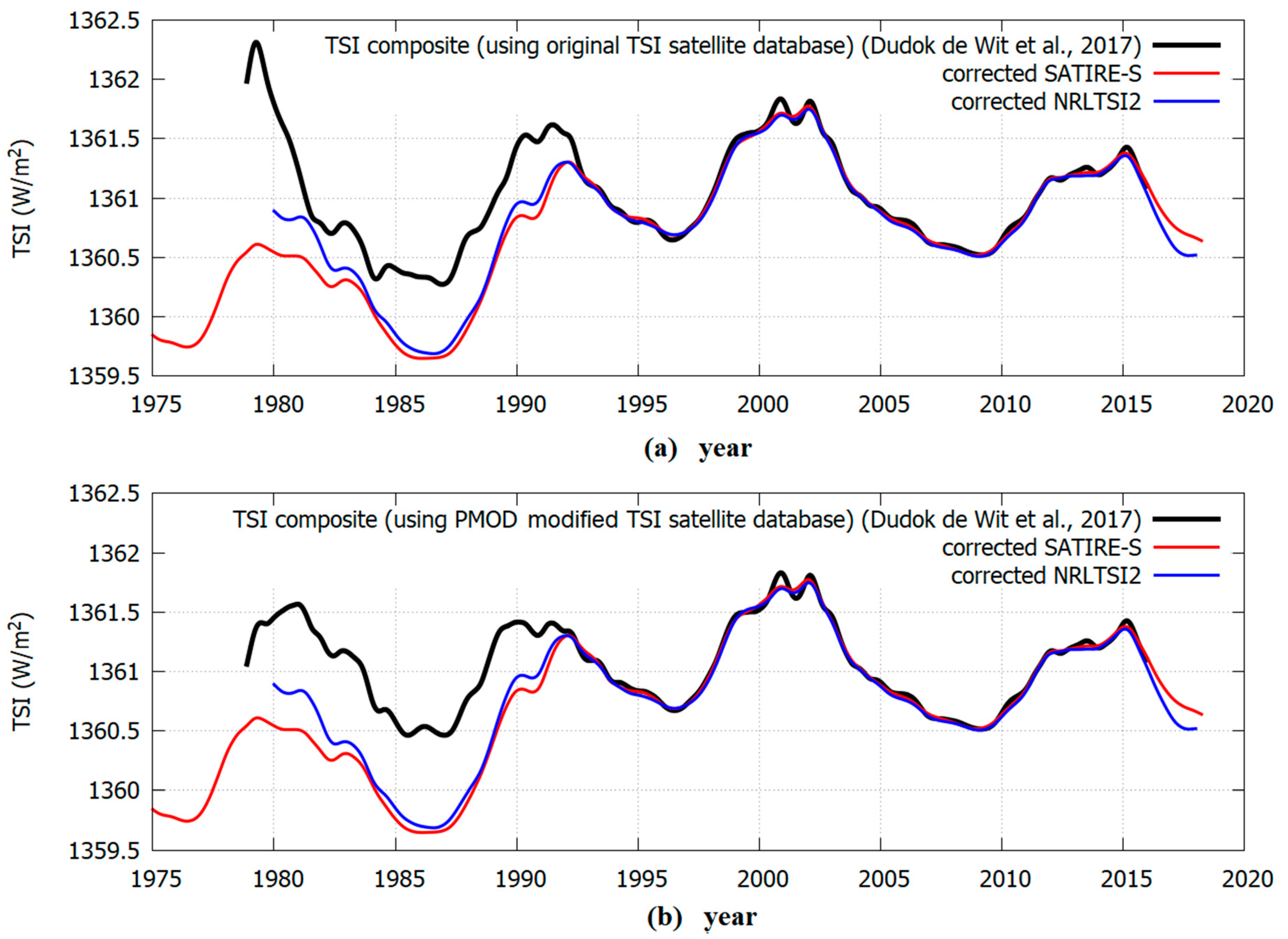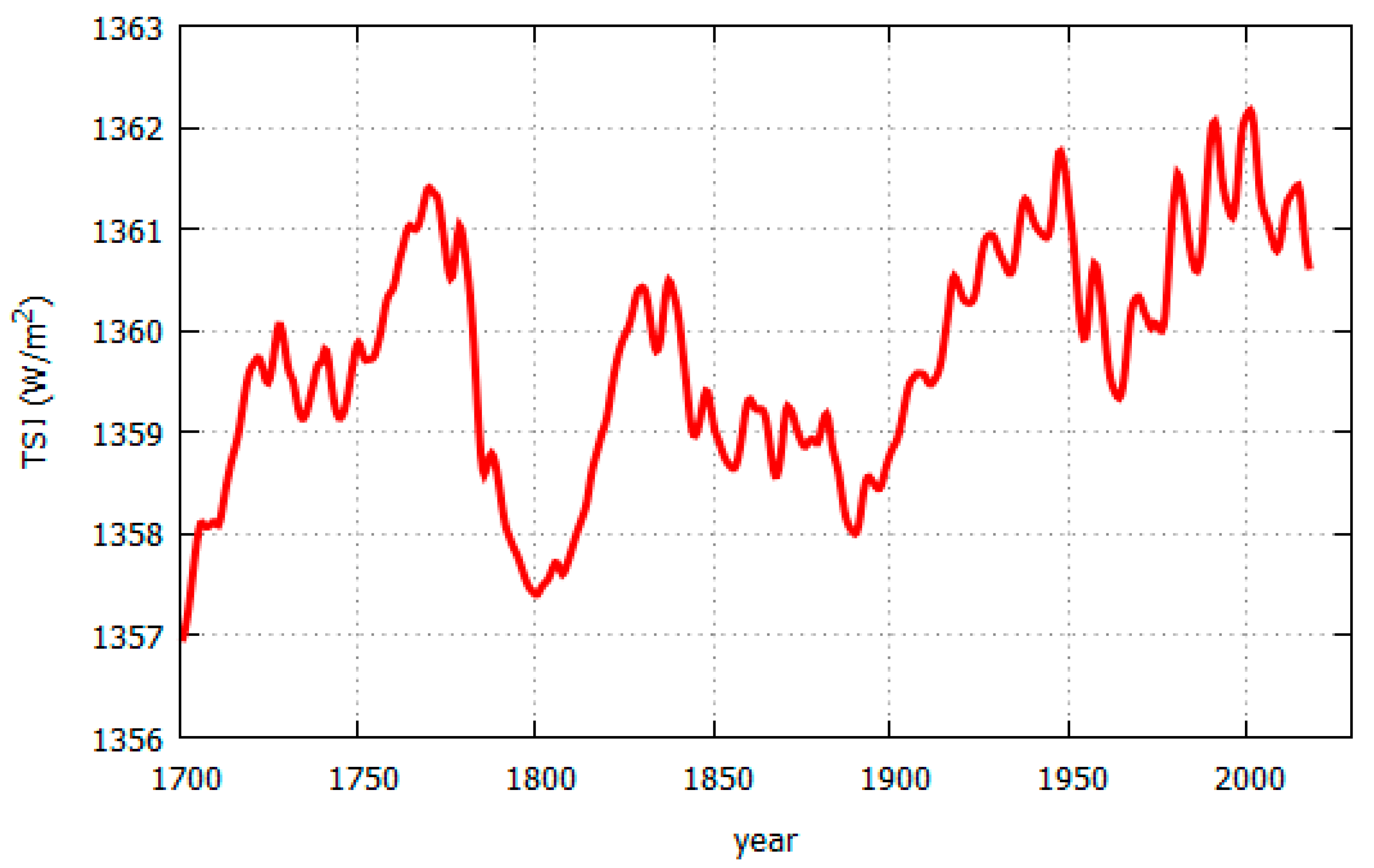1. Introduction
The total solar irradiance (TSI) is the solar energy flux density outside the Earth’s atmosphere at a distance from the sun of 1 astronomical unit (AU), given in SI units of Watts per square meter (W/m
2). The quiet solar luminosity variability on decadal to millennial timescales is still highly uncertain and is still the subject of much debate [
1,
2,
3,
4,
5,
6,
7,
8,
9,
10,
11,
12].
The quiet solar luminosity could undergo a significant decadal to millennial timescale variation because during the Maunder minimum (1645–1715), despite the near disappearance of sunspots, heliospheric activity was still significantly varying [
13,
14]. TSI proxy models attempting to take into account this behavior reproduce a large TSI variability both during the Maunder minimum and from 1700 to the present time between 3 and 6 W/m
2 [
1,
2,
8,
12]. Conversely, other recent TSI proxy models such as naval research laboratory total solar irradiance 2 (NRLTSI2) [
15] and spectral and total irradiance reconstructions-S (SATIRE-S) [
16] show a nearly flat TSI variability during the Maunder minimum and a TSI increase between then and the December 2008–2009 TSI cycle minimum of as low as 0.6 W/m
2 and 0.1 W/m
2, respectively [
3,
12] (
Appendix B lists the definition of all acronyms used in this paper).
Figure 1 shows examples of proposed TSI models characterized by a low or a high quiet solar luminosity variability. Solving this uncertainty is necessary for properly assessing the solar minimum-to-minimum trend, which is essential for understanding how solar activity evolves and its relationship to variability in the Earth’s climate [
17,
18,
19,
20,
21,
22,
23]. The eight records are depicted using a window of 7 W/m
2 to facilitate a visual comparison to highlight the difference in their secular variability.
The low decadal-to-millennial timescale variability observed in some TSI proxy models [
15,
16,
24] is likely due to the chosen model constructors that stress the time evolution of sunspot darkening, coronal mass ejections, facular brightening, and photospheric magnetism. These features are described by records such as the daily MgII index (at 280 nm, a proxy representative for the UVC and UVB spectral solar irradiance variability), radio flux record (at 10.7 cm, whose radiation comes from the high chromosphere and low corona and is generated by thermal Bremsstrahlung and gyro-radiation) and sunspot number and area records. However, these indices are mostly representative of the active regions of the sun such as photospheric sunspots and faculae and may poorly model the variability of the quiet solar luminosity that involves global solar changes. In fact, the chosen proxy records show a very small solar cycle minimum-to-minimum variability because very few sunspots and faculae are observed during solar cycle minima. Therefore, during such minima those records are bounded to the limit value of zero. On the contrary, according to some early study [
25], a TSI secular variation could also approach a 0.5%–1.0% over the past century, given the low precision of pre-1978 pyrheliometry and insufficient understanding of internal solar radiative physics.
The proper way to measure and evaluate the quiet solar luminosity variability is through direct TSI satellite observations and, in particular, through the analysis of the solar cycle minimum-to-minimum trending observed in their composites. However, the long-term trend in the TSI satellite records, available since 1978, remains also a scientific uncertainty that requires careful examination of the relevant issues from various perspectives. Two main factors explain this persisting disagreement: (1) the direct TSI satellite database is relatively short, ~40 years since 1978, and it is made of discontinuous records as depicted in
Figure 2 and (2) the proxy models cannot be properly evaluated and calibrated against the TSI observations due both to the shortness of the TSI satellite composite records and to the uncertainties in their solar cycle minimum-to-minimum trends, particularly from 1986 to 1996 [
26,
27,
28].
The scientific debate on this issue has become known as the active cavity radiometer irradiance monitor physikalisch-meteorologisches observatorium davos (ACRIM-PMOD) controversy and will be briefly reviewed in
Section 2. The main issue is whether TSI increased or decreased during the so-called ACRIM-gap period from 1989 to 1991. The ACRIM-Gap is the late 1989 to late 1991 period following the end of the solar maximum mission (SMM)/ACRIM1 and the start of the upper atmosphere research satellite (UARS)/ACRIM2 experiments during which time there were no high accuracy/precision TSI monitoring satellite experiments (
http://acrim.com).
Figure 2 compares the main TSI satellite records from 1978 to 2018. The most relevant ones are: SMM/ACRIM1 (1980–1989), UARS/ACRIM2 (1991–2001) and ACRIMSAT/ACRIM3 (1999–2013) [
26,
29,
30], Nimbus7/Earth radiation budget (ERB; 1978–1993) [
31], Earth radiation budget satellite/Earth radiation budget experiment (ERBS/ERB; 1984–2003) [
32], solar and heliospheric observatory/variability of solar irradiance and gravity oscillations (SOHO/VIRGO; 1996–present) [
27,
33] and solar radiation and climate experiment/total irradiance monitor (SORCE/TIM; 2003–present) [
10,
34].
Several TSI satellite composites have been proposed: ACRIM [
26], PMOD [
33,
35], RMIB [
36] and those suggested by Scafetta [
37] and Dudok de Wit et al. [
28]. Although these composites use different sets of TSI satellite records and merging methodologies, they are relatively equivalent since about 1992, the beginning of the ACRIM2 record, because they are all based on high-quality TSI observations. Yet, as clarified below, PMOD used their own modified versions of the original results compiled by the experiment teams for the SMM/ACRIM1, UARS/ACRIM2 and Nimbus7/ERB records to cover the period 1978–1992 and, therefore, its proposed record cannot be considered a real TSI satellite composite but a model construction. The ACRIM-PMOD controversy is about the scientific legitimacy of such modifications.
Herein we propose an alternative method to evaluate whether a TSI composite of the available satellite records should resemble more closely the ACRIM or PMOD records depicted in
Figure 3. We invert the PMOD approach of using TSI models to modify TSI observations and instead use the TSI observations to modify and fine-tune the low-frequency component of the TSI proxy models to determine how they would look if forced to mimic the data.
The proposed approach statistically models the discrepancy between the uncontroversial TSI observations before and after the ACRIM-gap period 1989.53–1991.76 and recent TSI proxy models that do not show a significant TSI minimum to minimum trend. In this way, we can ignore the controversial and low-quality Nimbus7/ERB and ERBS/ERBE records, which are the TSI records mostly responsible for the ACRIM-PMOD controversy, and solve the ACRIM-gap problem without them. We will show that the proxy models are found to exhibit different scaling errors relative to the data between the early and later periods. Then, a regression model can be developed to characterize and compensate for these errors. Finally, the same model can be used to empirically correct both the TSI proxy models and, simultaneously, cross-calibrate the ACRIM1 results with the post ACRIM-gap TSI records. This operation leads to new insights on the quiet solar luminosity variability in the 40+ year TSI record. The proposed solutions are further compared against the available TSI satellite composites to determine which one is the most consistent with the data.
2. A Review of the ACRIM-PMOD Controversy
A large uncertainty exists in the TSI composites during the period from 1978 to 1992. It is mostly due to the fact that the ACRIM2 mission was delayed because of the Space Shuttle Challenger disaster on January 28, 1986, which prevented this record from overlapping with the ACRIM1 record ending in July 1989 (1989.53). The ACRIM-gap (1989.53–1991.76) prevents a direct cross-calibration between the two high-quality ACRIM1 and ACRIM2 TSI records: see
Figure 2. ACRIM 1-2-3 records consist of high-quality TSI data made of up to 720 30-s averaged, self-calibrated, shuttered measurements per day [
26].
During the ACRIM-gap only results from the lower quality TSI records produced by Nimbus7/ERB and ERBS/ERBE are available. The quality of these TSI observations was limited by a lack of degradation self-calibration capability, by a lack of independent solar pointing and other issues. Moreover, for most of its lifetime, Nimbus7/ERB measured TSI only for a few minutes during each of an average of 14 orbits per day and missed one day every four [
31]. ERBS/ERBE was even more limited because it was also constrained to one shuttered observation every 14 days, on average [
32].
The main problem is that during the ACRIM-gap, Nimbus7/ERB and ERBS/ERBE records have incompatible trends. Nimbus7/ERB trends up (+0.26 ± 0.04 W/m
2yr) while ERBS/ERBE trends down (−0.26 ± 0.15 W/m
2yr): see
Figure 2 [
26,
27,
30,
33,
35,
38]. Both ACRIM and PMOD science teams agree that during that period at least one of these two TSI records was affected by serious instrumental problems. However, they disagree about which one is the most likely representation of TSI variability and should, therefore, be preferred to bridge ACRIM1 and ACRIM2 records across the gap.
PMOD used TSI proxy model predictions to claim that during the ACRIM-gap period Nimbus7/ERB sensor was affected by an increased sensitivity [
2,
27,
32,
33,
35,
39,
40,
41]. Consequently, during the gap, PMOD significantly altered the Nimbus7/ERB record downward by about 0.8–0.9 W/m
2 before connecting ACRIM1 and ACRIM2 [
38,
42] (
Figure 1 and
Figure 4). PMOD also made other TSI modifications to the data of the early periods of Nimbus7/ERB, ACRIM1 and ACRIM2, claiming uncorrected sensor degradations. PMOD data modifications were made without examination of original instrumentation, data or data reduction approaches or any detailed consultation with the original satellite experiment science teams. The proposed rationale was that models could be used to fine-tune experimental data. This idea was apparently first proposed in Lean et al. [
2] where it was claimed that deviations between TSI data and proxy models “may reflect instrumental effects” alone. Finally, Fröhlich and Lean [
35] proposed the first PMOD TSI composite that used Nimbus7/ERB, ACRIM1 and ACRIM2 TSI data they modified using specific TSI proxy model predictions [
32,
39].
The modification of accurate and precise satellite data using proxy models is a highly questionable approach. ACRIM claims that it is improper to modify published satellite data using virtually un-validated proxy models without detailed knowledge of the satellite instrumentation that only the science teams of the original experiments would likely have. Essentially, a proxy model study that highlights a discrepancy between data and predictions can only suggest the need to investigate a specific case. However, the necessity of adjusting the data and how to do it must still be experimentally justified. By not doing so, the risk is to manipulate the experimental data to support a particular solar model or other bias.
ACRIM contends that the Nimbus7/ERB TSI upward trend during the ACRIM-gap period is more likely correct than the ERBS/ERBE TSI downward trend because it agrees with the solar activity-TSI variability paradigm established by the ACRIM1 experiment [
42,
43]. In fact, the downward ERBE trend is at variance with the paradigm and was caused by well-documented degradation of its sensors that were experiencing their first exposure to the high UV radiation levels characteristic of solar activity maxima. High UV exposure is known to cause excess degradation of TSI sensors in other satellite results [
26,
30,
42,
44]. Nimbus7/ERB experienced a similar excess degradation 11 years earlier during the TSI maximum of solar cycle 21 [
38,
42] and would have already reached its asymptotic degradation limit during the ACRIM Gap. Clearly, the Nimbus7/ERB TSI record is the most reliable choice to relate the ACRIM1 and ACRIM2 records across the ACRIM-Gap.
However, both the ERB and ERBE TSI records could still contain secondary levels of inaccuracy caused by compromises of their experimental designs and operation, including a lack of independent solar pointing among other issues. The inaccuracy of the Nimbus7/ERB record was tested in Scafetta [
37] (
Figure 3) where it was determined that on a time scale of about 1–2 years, it could depart from ACRIM1 at most by ±0.2 W/m
2. This statistical bias is, however, significantly lower than the 0.8–0.9 W/m
2 drift hypothesized by PMOD. Thus, PMOD modifications of the Nimbus7/ERB record during the ACRIM-gap are statistically implausible and would require very robust experimental justifications that have not been made.
PMOD-proposed modifications of the experimental TSI records have always been uncertain despite their being labeled as “corrections”. Fröhlich and Lean [
35] claimed that Nimbus7/ERB had to be adjusted downward because of two presumed “glitches” occurred near October 1, 1989, and May 8, 1990, by −0.26 and −0.32 W/m
2 respectively. Fröhlich [
45] claimed that those same adjustments had to be −0.31 and −0.37 W/m
2. Fröhlich [
41] changed his previous opinion by claiming that the first glitch adjustment, now occurred on September 29, 1989, had to be adjusted with a −0.417 W/m
2 shift while the second glitch was “difficult to locate” and, therefore, he substituted it with a linear drift model requiring an additional correction of about −0.43 W/m
2.
Scafetta and Willson [
38] examined the PMOD modifications of Nimbus7/ERB. The first event was a postulated “glitch” on September 29, 1989, causing a sudden sensitivity increase that Fröhlich contended required a downward adjustment of −0.47 W/m
2 on that day. The second event was a postulated sensitivity drift requiring a total adjustment of −0.4 W/m
2 from 1989.5 to 1992.5. Finally, Fröhlich [
46] defended his modifications of Nimbus7/ERB, ACRIM1, and ACRIM2 TSI published records from critiques [
37,
47] by stressing his 15-year experience with the analysis of the VIRGO radiometers. However, VIRGO was compromised by failure of its shutter mechanisms at launch and required comparison with the other satellite TSI experiments and significant adjustments to provide a proxy to true differentially shuttered results. Additionally VIRGO sensors experienced excessive degradation during its mission that provided another significant source of uncertainty. It is unlikely that the quality of VIRGO results would be adequate to justify alterations of TSI data produced by the other ongoing experiments in which the VIRGO team was not directly involved or had made no significant effort to discuss the issue in detail with the original experiment teams. Thus, the proposed PMOD “corrections” of the Nimbus7/ERB, ACRIM1 and ACRIM2 published TSI records can only be considered conjectures.
In the case of Nimbus7/ERB, tests were performed by its original experimental team that disproved Frohlich’s claims as demonstrated in the supplemental file published in Scafetta and Willson [
47]. This supplement includes a testimonial by Dr. Hoyt (the director and technical authority for the Nimbus7/ERB mission) that the claim of a spurious sensitivity increase of the Nimbus7/ERB sensor during the ACRIM-gap was carefully investigated and dismissed from an experimental perspective. Hoyt concluded his testimonial by stating that “Frohlich’s PMOD TSI composite is not consistent with the internal data or physics of the Nimbus7 cavity radiometer” (see
Appendix A). The ACRIM science team also evaluated the PMOD alterations of some early ACRIM1 and ACRIM2 published records and found them to be unwarranted because the claimed early degradation of their sensors [
2] had been already properly corrected using ACRIM instrumentation sensor redundancy and no further adjustment was required [
26] (supplement). The supplement of Ref. [
26] also contains a link to a critical testimonial of Willson regarding PMOD modifications of ACRIM1 and ACRIM2 datasets (published in Scafetta [
21]). Thus, both Willson and Hoyt, the principal investigators of the ACRIM and Nimbus7/ERB TSI satellite experiments, respectively, are convinced that the PMOD modifications of their TSI published records are unjustified.
In support of Hoyt’s testimony, Scafetta and Willson [
38,
47] showed that the PMOD’s claims and downward modifications of the Nimbus7/ERB record during the ACRIM-gap are contradicted by numerous pieces of evidence. For example, the PMOD hypothesized 9/29/1989 glitch of the Nimbus7/ERB sensor is contradicted by direct comparison with the ERBS/ERBE record [
37,
38] and by the fact that the observed divergence between NIMBUS7/ERB and ERBS/ERBE occurred during October and November 1989. Moreover, this event was not instantaneous but gradual: a fact that could be explained by a rapid degradation of the ERBS/ERBE sensor during those months discussed above [
37,
38].
PMOD’s claim of an anomalous sensitivity increase of the Nimbus7/ERB sensor during the ACRIM-gap was originally proposed by Lee III et al. [
32]. These authors claimed that a simple multi-regression TSI proxy model based upon the 10.7-cm solar radio flux (F10) and the photometric sunspot index (PSI) was able to identify TSI variability trends due to drifts or shifts in the spacecraft sensor responses. They found that their TSI proxy model diverged from Nimbus7/ERB during the ACRIM gap and concluded that its experimental data required adjustments. However, it is evident that the Lee III et al. [
32] result could also be interpreted as meaning that their TSI proxy model was not able to track the real TSI variability, in particular during a solar maximum period when the quiet solar luminosity could gradually evolve as well. Moreover, as both F10 and PSI indexes are indicative of the active solar regions and do not show any trend between consecutive solar cycle minima, any fit model constructed using them alone would not show any TSI cycle minimum-to-minimum variability by construction. Thus, Lee’s chosen solar model is improper because it lacked the specific physical property—namely the possibility of a solar cycle minimum-to-minimum trending—that would be necessary to test whether the quiet solar luminosity varies or not from a solar cycle to the next. Indeed, TSI proxy models based on PSI and MgII index underestimate TSI observations at the time of solar cycle 21 and 22 maximum and during the beginning of its TSI decline toward solar minimum and, therefore, the validity of these models should not be overstated [
48].
In contrast, Scafetta and Willson [
38] (
Figure 5b) showed that during the ACRIM-gap the Kitt Peak National Solar Observatory solar magnetic field strength (SMFS) trends upward so the solar activity-TSI paradigm would predict a corresponding upward TSI trend, which strongly supports the Nimbus7/ERB upward trend during the same period. Similar conclusions were implied by alternative solar magnetic field strength measurements [
38].
It is evident that the result regarding whether during the ACRIM-gap Nimbus7/ERB record is well represented or not by a solar proxy model depends on the specific model or solar observable one chooses. Therefore, the claims by Lean et al. [
2], Lee III et al. [
32] and Chapman et al. [
39], which were later reiterated by PMOD [
27,
35,
40], are doubtful. Other considerations supporting the TSI upward trending between 1980 and 2000, shown by the ACRIM TSI composite, will be briefly discussed in
Section 6.
As explained in the introduction, the contrasting claims of ACRIM and PMOD yielded two alternative TSI satellite composites showing a different multi-decadal trending during solar cycles 21–24, as shown in
Figure 3. The ACRIM TSI composite shows a ~0.46 W/m
2 increase between the solar cycle minima that occurred in 1986 and 1996 followed by a decrease of ~0.27 W/m
2 between the solar cycle minima occurred in 1996 and 2008. The PMOD TSI record shows an accelerating downward trend with a 1986 to 1996 decrease of ~0.05 W/m
2 followed by a decrease of ~0.13 W/m
2 between 1996 and 2009 [
38] (
Figure 2). By using all available TSI satellite records, Scafetta (2011) demonstrated that the TSI mean variation between the 1986 and 1996 solar cycle minima ranges between –0.11 ± 0.1 W/m
2 (by bridging the ACRIM-gap using ERBS/ERBE) and +0.67 ± 0.1 W/m
2 (by bridging the ACRIM-gap using Nimbus7/ERB). Thus, ACRIM shows an upward trend from 1980 to 2000, while PMOD shows a downward trend during the same period. This difference is crucial to the investigation of the significance of TSI variability in climate change. If correct, the rising solar activity revealed in the ACRIM TSI composite would be the primary driver for the global warming observed during the last decades of the 20th century [
17,
19,
30,
37,
42,
49].
More recently, Dudok de Wit et al. [
28] questioned whether the original satellite measured TSI database or the PMOD modified version should be used. They could not solve the problem and provided two preliminary versions of the TSI composite dependent on decisions about the data uncertainty: see
Figure 4. In the following, we will propose a model test that uses the ACRIM1 records and the TSI composites by Dudok de Wit et al. [
28] after the ACRIM-gap. Therefore, the controversial TSI records during the ACRIM-gap will be ignored as explained in the next sections.
Scafetta and Willson [
42] had some critiques of the Dudok de Wit et al. work [
28]. For example, it contains erroneous claims that ERBS/ERBE was the “only instrument observing during” the ACRIM-gap period while also showing the Nimbus7/ERB results in their
Figure 1. They advocated for PMOD by claiming that there is “a growing consensus that Fröhlich’s corrections are a justifiable improvement to the original data”, ignoring the critical analyses of the original experimental teams that indicate otherwise [
26,
38,
47] and providing no analytical alternatives. Dudok de Wit et al. [
28] erroneously claimed their TSI composites better agree with PMOD than with ACRIM. In fact, this has been found not to be the case [
42], as
Figure 4 demonstrates since both TSI composites show an increase between 1986 and 1996.
Finally, Dudok de Wit et al. [
28] claimed that their TSI composites are affected by such large uncertainties (up to σ = 0.7 W/m
2 using the original TSI dataset, see
Figure 4a, and up to σ = 0.4 W/m
2 using the modified TSI dataset, see
Figure 4b) that it is impossible to discriminate between them or between the ACRIM and PMOD TSI records since 1981. Consequently, it would also be impossible to evaluate the TSI proxy models’ ability to reconstruct the quiet solar luminosity variability. However, a similar uncertainty issue was first noted and discussed in Scafetta [
50] where it was determined that a large uncertainty curve originates when the cross-calibration of the TSI records uses very short overlapping intervals, like that used in the wavelet methodology by Dudok de Wit et al. [
28]. Scafetta [
50] determined the maximum possible composite uncertainty, which occurs using a point-to-point comparison of the various TSI datasets and obtained a similar, although slightly larger uncertainty curve. When all overlapping data are used at once, and one distinguishes between Nimbus7/ERB and ERBS/ERBE, the statistical uncertainty of the composites is greatly reduced because it scales with the root of the number of overlapping points [
37]. Moreover, if we assume that the TSI uncertainty function evaluated in Dudok de Wit et al. [
28] is meaningful, the comparison between their two proposed TSI composites should be made using some moving average smooth curve of the provided daily TSI records and the uncertainty range decreases with the root of the window size of the smoothing algorithm. For example, because the data have a daily resolution, the uncertainty associated with a 1–2 year moving average smooth curve (the statistical model proposed later by us will have approximately this resolution) would be about 20–27 times smaller than the daily uncertainty. Consequently, using a 1–2 year smoothed curve the uncertainty will be less than 0.035–0.025 W/m
2. This value is significantly smaller than the difference between the two TSI composites by Dudok de Wit et al. [
28] (see
Table 1) and it is up to 15–20 times smaller than the difference between ACRIM and PMOD TSI records from the TSI cycle minima in 1986 and 1996 (that is 0.45 + 0.08 = 0.53 W/m
2). When these considerations are taken into account, the two TSI composites by Dudok de Wit et al. [
28], as well as those proposed by ACRIM and PMOD are clearly distinguishable within their statistical uncertainty. Consequently, the various proposed solar models can be tested and evaluated against the data.
Dudok de Wit et al. [
28] also noted that the variation functions among ACRIM3, VIRGO and SORCE-TIM from 2003–2013 appear equivalent to a 1/f red noise. Red noises are auto-regressive cumulative noises with long-range correlations. This result is likely due to the slight different sensitivity of the three experimental sensors [
30]. It is difficult to assess which TSI record among the three better reproduced TSI data sets. However, it should be pointed out that VIRGO appears to be the most uncertain record because its main sensor (PMO6V-A) experienced an exceptionally large degradation of about 6 W/m
2 (nearly 4500 ppm) from 1996 to 2014, which has been corrected as discussed above [
44]. VIRGO also experienced other satellite problems such as a failure of the PMO6V shutters at launch, which is responsible for their excessive degradation [
26] (supplement). Both ACRIM3 and SORCE-TIM main sensors’ shutters worked properly and degraded much less by about 1000 and 200 ppm, respectively throughout their missions and therefore had self-calibration capabilities in space far more accurate than VIRGO’s [
30,
34]. The SORCE-TIM TSI record appears to have the least variability on the shortest observational timescales of the three experiments. This is most evident during the solar cycle minimum during 2008–2009: see
Figure 2 [
30] (
Figure 4 and
Figure 5). This is likely caused by the lower sensitivity of the TIM sensor. Between 2013 and 2014 SORCE-TIM also suffered a serious battery shutdown and failure that lasted about 7 months. Since 2003, both ACRIM3 and VIRGO show a more pronounced down-trending than SORCE-TIM [
30]. The above considerations imply that among the three experiments ACRIM3 may better reproduce TSI variation until the first months of 2013.
While it is possible that any TSI measurements may be inaccurate because of some sensitivity issues, this possibility cannot be used to address the ACRIM-gap problem since we can only use ACRIM1 and ACRIM2 records. These two records do not overlap and, therefore, it is not possible to assess whether they deviate from each other according to a 1/f noise or anything else. Only random uncertainties can be assumed. On the contrary, any persistent bias between them and the proxy models needs to be ascribed to the inability of the latter to adequately reconstruct TSI variability in general, in particular during and around solar maxima [
48]. In fact, proxy models frequently have significant differences from each as well. The challenge would be to find a way to reach a result convergence, as we will show below.
6. Discussion
The above analysis suggests that the TSI proxy model proposed by Gueymard [
24] was too unstable and, consequently, also the attempt to correct it using the regression methodology of Equation (1) could produce an unreliable result. On the contrary, the results obtained with the SATIRE and NRLTSI2 models were more consistent with each other.
Figure 11 shows the modified SATIRE-S and NRLTSI2 TSI proxy models shown in
Figure 9. It was observed that the two proxy models now agreed well with each other and with the TSI composite obtained using the original database within a 0.1 W/m
2 error for most of the overlapping period from 1981 to 2016: see
Figure 11a. The significant discrepancy observed from 1978 to 1981 was caused by the uncorrected degradation of the Nimbus7/ERB record, as explained above.
A slightly better agreement for the period 1981–1992 between the modified TSI proxy model curves with the observations could possibly be obtained if the TSI composite would not use the ERBS/ERBE record, which was the one with the largest uncertainty and was affected by significant degradation from 1989 to 1992 during its first exposure to the high UV emissions during the maximum of the solar cycle 22. Not using the ERBS/ERBE record in the TSI composite should result in a slightly lower TSI minimum in 1986.
On the contrary,
Figure 11b shows that there still persisted a significant discrepancy up to 0.3 W/m
2 with the TSI composite obtained using the PMOD’s modified TSI database. Thus, the evidence was that those modifications worsened the discrepancy with the proxy models and, therefore, they were likely incorrect.
Indeed, the good agreement between the two modified proxy models and the TSI composite from 1981 to 1992 using the original TSI database depicted in
Figure 11a suggest that the result was consistent and robust. In fact, the SATIRE-S and the NRLTSI2 proxy models were independently constructed and the regression correction model proposed in Eqs. 1 and 2 did not use the TSI composite values prior to 1991.76.
Figure 12 is analogous to
Figure 11 but now the TSI proxy models were modulated according to the results depicted in
Figure 10 where the calibration used the second TSI composite by Dudok de Wit et al. [
28] made with the PMOD modified TSI satellite database. The modified SATIRE-S and the NRLTSI2 proxy models were again highly correlated and show a TSI increase between the solar cycle minima in 1986 and 1996 of about 1 W/m
2. However, both models poorly correlated with both TSI composites by Dudok de Wit et al. [
28] for the period 1980–1991.76.
The modeled TSI pattern suggests that 2000–2002 could have been a grand solar maximum.
Figure 13 shows a TSI evolutionary model that used the solar proxy model [
1] that attempted to reconstruct the quiet solar luminosity variability based on Schwabe cycle length (rather than average solar cycle amplitude). This model was extended using the ACRIM composite since 1981 and an average between VIRGO and SORCE TIM since 2013. This particular TSI model appeared to correlate well with the Earth’s global surface temperature records since 1700 [
1,
20,
21,
51].
The TSI data from 1978 to 1981 appeared too corrupted because of uncorrected degradation of the Nimbus7/ERB sensors during the solar maximum of cycle 21. For this reason, it was more appropriate to dismiss the data from this period because modifying TSI data using proxy models, as done by PMOD, would be arbitrary. We proposed that any reliable TSI composite should begin from late 1980 with the ACRIM1 record.
The currently proposed TSI proxy models, such as SATIRE and NRLTSI2, appeared to be more reliable in reconstructing the fast fluctuations of TSI variability but failed to properly model longer low-frequency timescales. In particular, they were found to best agree with the TSI composites after 1996. However, a progressive divergence was observed for the early period (e.g., 1981–1996). This suggests that the relation between TSI and its used proxies was not stationary but varied in time. Probably their scaling errors also evolved in time. Due to the non-stationary uncertainties in the observations, these proxy models were likely missing a slowly varying TSI component that needed to be non-linearly coupled with the typical adopted solar proxies (SSN and SSA, MgII, F106, etc.), which were more indicative of the active solar regions. Therefore, there was a need to develop better quiet sun luminosity models as the proposed evidence indicates that TSI background levels may vary significantly from cycle to cycle.
An increase in solar activity from 1970 to 2000 is predicted by alternative solar theoretical models. One model predicting such a TSI increase between 1986 and 1996 was based on the negative correlation found between solar cycle length and solar and climate variability on century timescales [
1,
51,
52]. This model predicted the recent TSI increase because solar cycle 22 (1986–1996) was 9.9-year long and was significantly shorter than the 11-year Schwabe solar cycle length mean and shorter than both solar cycle 21 (1976–1986, 10.5 year) and solar cycle 23 (1996–2008, 12.3 year). According to this model, the shortness of cycles 21 and 22 should have progressively stressed the solar dynamo and increased the quiet solar luminosity variability from the 1970s to 2000. During the maximum of solar cycle 22 this TSI behavior would be confirmed by the upward trending observed in the Nimbus7/ERB TSI record and in other solar magnetic activity records during the ACRIM-gap [
38]. The decrease of solar activity observed since 2000 may have been caused by the solar dynamo slowdown of cycle 23 that would likely persist for solar cycle 24 as well. It should be noticed that a negative correlation was also found between the Earth’s global surface temperature and the Earth’s length of the day (LOD) record, suggesting a direct link between the surface temperature of a celestial body and overall circulation patterns of its atmosphere [
53].
The multi-decadal to millennial solar activity oscillations could be interpreted and reconstructed by using also the astronomical resonances of the solar system. In fact, they appear to drive and synchronize the main solar oscillations [
54,
55,
56]. More specifically, a TSI peak in the 1940s, its following decrease until around 1970 and again its increase from 1970 to 2000 and decrease afterward (cf.
Figure 13) would be part of a 60-year oscillation. This is one of the typical oscillations commonly observed in climate ([
20,
21,
57]; and references therein) and solar records [
58,
59,
60] based on actual observations. Scafetta’s [
54] harmonic solar model predicted several decadal to millennial solar and climate oscillations throughout the entire Holocene and even during the Marine Interglacial Stage 9.3 that occurred 325–336 kyear ago [
56,
61]. According to this interpretation, the 2000–2002 TSI peak was caused by the maximum of the gravitational pull of Jupiter and Saturn on the sun that reached its 60-year cycle maximum around 2000. This gravitational pull could have increased solar luminosity production by a tidal forcing [
55]. Other interpretations involving an electromagnetic coupling between the sun and the planets may be also possible [
62,
63]. The same harmonic solar model suggests that the sun may now be heading toward a new grand solar minimum in the 2030–2040 time frame.
Final evidence that TSI may have increased from 1980 to 2000 comes from Earth’s climate studies. Secular climate records correlate well with TSI curves such as the one depicted in
Figure 13 and on longer ones covering the entire Holocene [
1,
23,
60,
64]. In particular, the warming observed from 1970 to 2000, followed by a temperature standstill since 2000, is a good fit for a natural 60-year cycle prediction superimposed to other contributions [
20]. This pattern correlates better with a TSI evolution similar to the ACRIM composite [
17,
18,
19,
20,
21,
62,
65] than with the CMIP5 general circulation climate model predictions of continuous anthropogenic warming [
22]. The CMIP5 climate models use a high climate sensitivity to CO
2 forcing and low secular TSI variability proxy models, such as the one proposed in [
3], which was calibrated using the PMOD TSI composite model after 1980.
7. Conclusions
Herein we reviewed the ACRIM-PMOD controversy regarding whether TSI increased from 1980 to 2000 and proposed an alternative solution. Solving this issue is crucial to understand how the quiet solar luminosity varies and it is important for climate change studies. This controversy can be reduced to the issue of the appropriateness of modifying TSI observations using TSI proxy model predictions. Our finding was that the disagreements between TSI observations and proxy model predictions were primarily caused by flaws in the models, indicating that the relationships between solar physical models and TSI variability was not yet well-understood.
We noted that Pap et al. [
48] came also to the conclusion that the disagreement between data and proxy models “seems to be more of a problem with the models than with the instruments”. Yet only a few years later, despite this finding, TSI proxy models were used to empirically “correct” TSI observations to produce the PMOD TSI composites [
35,
40]. The approach adopted by Fröhlich and Lean [
35,
40] involved no work with the original observational data or in-depth consultation with the TSI satellite experiment teams. Yet, the PMOD composite was favored by part of the scientific community [
22,
28] despite objections from the original TSI experiment teams who could find no experimental issues to justify the satellite data modifications proposed by Frohlich and Lean. See Willson and Mordvinov [
26] and Hoyt’s statement in Scafetta and Willson [
38] that is partially reproduced in
Appendix A.
Here we reversed the PMOD approach. We used the uncontroversial TSI observations before and after the ACRIM-gap period (1989.53–1991.67) to empirically adjust the low-frequency component of the TSI proxy models in an attempt to bridge the gap. This approach explicitly allows the possibility that those proposed models could be missing a slow varying solar luminosity component of the quiet sun regions. In brief, we attempted to solve the ACRIM-gap problem by ignoring both Nimbus/ERBS and ERBS/ERBE, lower quality TSI records than ACRIM1 and ACRIM2, and evaluated how the modified proxy models reconstruct the rising and declining periods of solar cycle 22, just before and after the gap, respectively. Our statistical methodology modeled the biannual trending of the TSI record from 1978 to date and bridged the ACRIM-gap. Although the proposed regression methodology works best when the records do not have gaps, it may still be reliable for bridging minor gaps in the data by reconstructing its optimal geometry as suggested by the entire record.
We found that the models underestimated the TSI cycle 22 rising trend and overestimated the solar cycle 22 declining trend. Problems in properly reconstructing solar cycles 23 and 24 maxima were also observed. Such divergences have been typically observed and are likely due to solar effects not taken into account in the models [
66]. After empirically adjusting the models for these biases, our best result appeared to be the one shown in
Figure 11A where we found consistency between the adjusted proxy models and the TSI composite proposed by Dudok de Wit et al. [
28] constructed with the unmodified TSI database since about 1981. This composite shows better agreement with the ACRIM composite than with PMOD.
Our method provides a new TSI data record showing TSI increased by at least 0.4 W/m2 from the 1986 to the 1996 solar cycle minimum and twice as much from 1980 to 2002. It decreased since 2002 by ~0.15 W/m2 from the 1996 to the 2009 solar cycle minimum. The ACRIM TSI composite shows a very similar pattern with a slightly larger increase of about 0.46 W/m2 between 1996 and 2008 and a decrease of about 0.27 W/m2 between 1996 and 2009. The PMOD TSI record shows an incompatible pattern with a slight decrease of ~0.05 W/m2 from 1986 to 1996 followed by an additional decrease of ~0.13 W/m2 between 1996 and 2009.
The above result was consistent with those already shown in Scafetta and Willson [
38,
47] using other TSI models. Scafetta and Willson [
47] bridged the ACRIM-gap using the SATIRE-T model proposed by Krivova et al. [
67], which was labeled KBS07 and showed that the resulting ACRIM-KBS07 and PMOD-KBS07 constructions confirmed the ACRIM composite trend. Krivova et al. [
68] critiqued the result claiming that their SATIRE-T model was not supposed to accurately reconstruct TSI changes on the monthly time scales but only on the decadal-scale and above. However, Scafetta and Willson [
38] showed that during the ACRIM-gap PMOD diverged also from the TSI models of Wenzler et al. [
69] and Ball et al. [
70]. Moreover, it was shown that the divergences between the SATIRE-T model and the data on a decadal time scale provided a confirmation of the trending shown by the ACRIM TSI composite. The SATIRE-S model was also analyzed and the result was still the same: the divergence between the data and the model confirmed a TSI upward trend during the ACRIM-gap and, therefore, the ACRIM TSI satellite composite trending. Thus, the claimed agreement between PMOD and several TSI models appeared coincidental because it seemed due simply to the inability of these models to properly reconstruct the quiet solar luminosity variability.
A reliable assessment of the quiet solar luminosity variation depends on continuous and accurately calibrated TSI measurements. The Total and Spectral Solar Irradiance Sensor-1 (TSIS-1) on the International Space Station began measuring TSI since 2018 to extend the 40 years of TSI observations. The Total Solar Irradiance Monitor (TSIM) onboard the Chinese Feng Yun-3C (FY-3C) satellite is also measuring TSI from space since 2013 [
71,
72]. The importance of the long term TSI measurement database cannot be overemphasized for understanding the TSI variability on decadal to millennial timescales in the past, to assess the TSI variability impact on climate change in the future.
